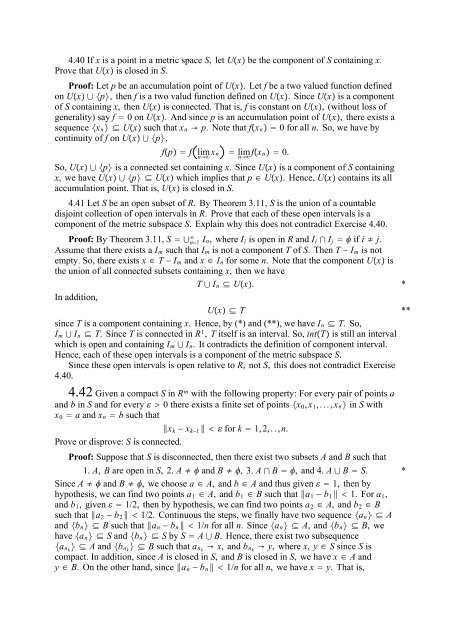The Real And Complex Number Systems
The Real And Complex Number Systems
The Real And Complex Number Systems
You also want an ePaper? Increase the reach of your titles
YUMPU automatically turns print PDFs into web optimized ePapers that Google loves.
4.40 If x is a point in a metric space S, letUx be the component of S containing x.<br />
Prove that Ux is closed in S.<br />
Proof: Let p be an accumulation point of Ux. Letf be a two valued function defined<br />
on Ux p, then f is a two valud function defined on Ux. SinceUx is a component<br />
of S containing x, then Ux is connected. That is, f is constant on Ux, (without loss of<br />
generality) say f 0onUx. <strong>And</strong> since p is an accumulation point of Ux, there exists a<br />
sequence x n Ux such that x n p. Note that fx n 0 for all n. So, we have by<br />
continuity of f on Ux p,<br />
fp f lim n<br />
x n<br />
lim n<br />
fx n 0.<br />
So, Ux p is a connected set containing x. SinceUx is a component of S containing<br />
x, wehaveUx p Ux which implies that p Ux. Hence, Ux contains its all<br />
accumulation point. That is, Ux is closed in S.<br />
4.41 Let S be an open subset of R. By <strong>The</strong>orem 3.11, S is the union of a countable<br />
disjoint collection of open intervals in R. Prove that each of these open intervals is a<br />
component of the metric subspace S. Explain why this does not contradict Exercise 4.40.<br />
Proof: By <strong>The</strong>orem 3.11, S <br />
n1 I n ,whereI i is open in R and I i I j if i j.<br />
Assume that there exists a I m such that I m is not a component T of S. <strong>The</strong>n T I m is not<br />
empty. So, there exists x T I m and x I n for some n. Note that the component Ux is<br />
the union of all connected subsets containing x, then we have<br />
T I n Ux. *<br />
In addition,<br />
Ux T **<br />
since T is a component containing x. Hence, by (*) and (**), we have I n T. So,<br />
I m I n T. SinceT is connected in R 1 , T itself is an interval. So, intT is still an interval<br />
which is open and containing I m I n . It contradicts the definition of component interval.<br />
Hence, each of these open intervals is a component of the metric subspace S.<br />
Since these open intervals is open relative to R, not S, this does not contradict Exercise<br />
4.40.<br />
4.42 Given a compact S in R m with the following property: For every pair of points a<br />
and b in S and for every 0 there exists a finite set of points x 0 , x 1 ,...,x n in S with<br />
x 0 a and x n b such that<br />
x k x k1 for k 1,2,..,n.<br />
Prove or disprove: S is connected.<br />
Proof: Suppose that S is disconnected, then there exist two subsets A and B such that<br />
1. A, B are open in S, 2.A and B , 3.A B , and 4. A B S. *<br />
Since A and B , we choose a A, andb A and thus given 1, then by<br />
hypothesis, we can find two points a 1 A, andb 1 B such that a 1 b 1 1. For a 1 ,<br />
and b 1 ,given 1/2, then by hypothesis, we can find two points a 2 A, andb 2 B<br />
such that a 2 b 2 1/2. Continuous the steps, we finally have two sequence a n A<br />
and b n B such that a n b n 1/n for all n. Sincea n A, andb n B, we<br />
have a n S and b n S by S A B. Hence, there exist two subsequence<br />
a nk A and b nk B such that a nk x, andb nk y, wherex, y S since S is<br />
compact. In addition, since A is closed in S, andB is closed in S, wehavex A and<br />
y B. On the other hand, since a n b n 1/n for all n, wehavex y. Thatis,
















